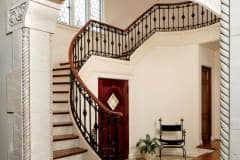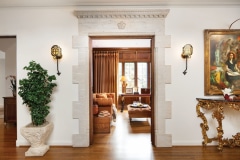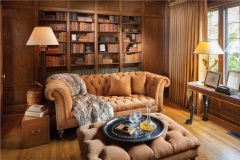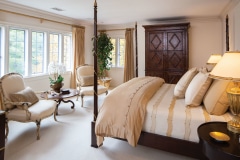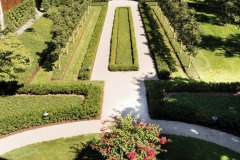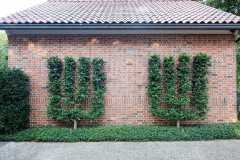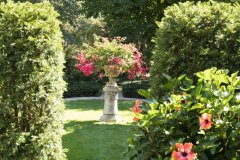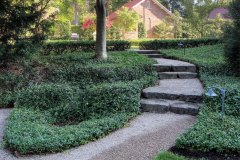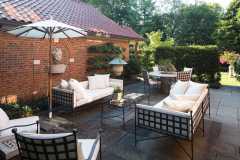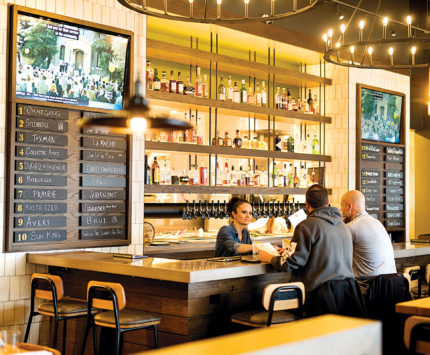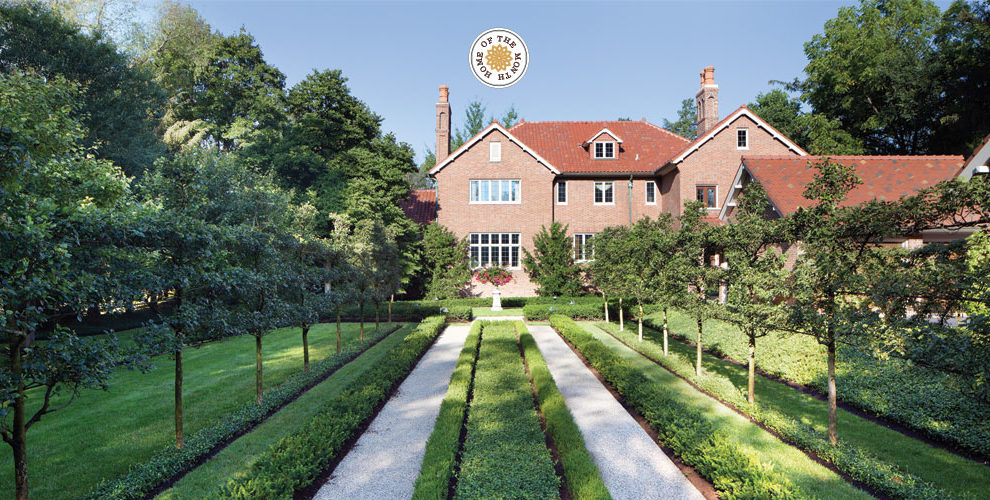
Home Of The Month: Well Manored

Inside are exquisite original features no common on the historic street, such as stone doorways and travertine in the entrance that continues outside to the front stoop.Photography by Tony Valainis
When Joyce Butterworth brought her construction-savvy brother to check out the English manor she had fallen for in Meridian-Kessler—the one with trees growing out of its chimneys—he had one question: “Joyce, have you lost your mind?” The beautiful home had sat vacant for some time before Joyce toured it, and yes, it needed a little TLC. In her eyes, though, a few trees were nothing compared to the palladium windows, intricate brickwork, and regal appearance. She bought the home with her late husband, disregarding her brother’s warning. Some 16 years later, Joyce laughs at the memory. “He’s normally a calm, cool, collected guy,” she says.
Looking back, she admits that she had no idea what she was getting into, or the sheer magnitude of the work required for a full restoration. From the beginning, she fell in love with the home’s unique features and architecture, but it needed updates that ranged from cosmetic fixes to rewiring all electrical systems, and none of it was easy. Its entire first floor is hardwood, over 10-inch poured concrete on top of a steel foundation. Drilling through this to run new plumbing and electrical was just one of many challenges they faced.
The 95-year-old home is built like a fortress, thanks to the planning and design of its original owner, John Esterline—an engineer, philanthropist, and founder of Eagle Creek Nursery. Even though the Esterlines sold the home in the 1960s, remnants of their ownership remain. Both the Esterline family crest and a Mayflower emblem, for Mrs. Esterline’s heritage, are carved into limestone.
The whole home was restructured and restored from top to bottom—no room was left untouched. Surprisingly, the four-bedroom, six-bath floor plan was never added onto or opened up over the years, and Joyce loves that about it. She finds the layout and size charming. The kitchen’s footprint remained the same, but was remodeled with custom walnut cabinetry and a balcony that overlooks the garden—its French doors are often open during the summer while the homeowners cook. What’s now the lower-level living space was once part of the old garage. In order to maximize the backyard and create a better flow, they walled off the garage and converted it to living space, raised the backyard 11 feet, and built two handsome detached garages with Honduran mahogany doors and hand-forged hardware.
Throughout the whole process, restoration was key. Any changes needed to stay true to the home’s history. “There has to be some formality to a house like this,” Joyce says. Carefully chosen elegance is seen throughout, from the hand-painted Fortuny chandeliers in the dining room to peachy Rosso Verona marble from Italy in the master bath. On the first floor, the quarter-sawn white oak floors have been beautifully refinished, their gleaming wood grain now accentuated by antique rugs. Contributing to the home’s Italian Renaissance flair, each doorway is trimmed with molded Italian marble that the architect restored and, when necessary, reproduced to match what was there originally.

The original footprint remains with a walnut library.Photography by Tony Valainis
It’s no coincidence that their efforts turned out so well. The architect who worked on the home’s restoration was H. Roll McLaughlin, a founding member of the Historic Landmarks Foundation (now known as Indiana Landmarks) and considered by many in the community to be the godfather of historic preservation in Indianapolis. He loved the house as soon as he saw it, and, like many other professionals who worked on the project, appreciated its exterior masonry. The exterior brick is laid in Flemish Bond, a style that dates to the 17th century and requires significant time and skill. Every other brick is laid on end for a refined, classic appearance.
Joyce now shares the home with her fiancé, Steve, and artifacts from their travels are seen in nearly every room, with a wonderful story accompanying almost every item. She uses antique Chinese stirrups as candle holders and Tibetan offering urns to decorate the dining room table. “Everyone always wants to know what these are, and I just thought they were so interesting,” Joyce says. She found them at The Golden Triangle in Chicago, a choice spot of theirs that sells fascinating relics. Woolly mammoth beads are draped across a stack of books in the solarium, the top one aptly titled I Married Adventure—a sweet nod to her life with Steve.

The solarium overlooks the side yard, where both the Honduran mahogany door and the Mayflower crest above it are original to the house.Photography by Tony Valainis
They love art, especially work by Indiana artists, and their home features the likes of C.W. Mundy, Denise Frazier Pettee, and Todd Reifers. In the living room, lustrous Venetian plaster walls provide the perfect backdrop for one of their favorite paintings, Frank Mason’s Passing Parade. After watching A Light in the Dark: The Art & Life of Frank Mason, a documentary that featured the painting, they spoke to the documentarian, Mason’s grandnephew, who told them the scene, the view from a second-floor window, depicted Piazza Capranica in Rome. So they set off to find it, and by sheer conicidence, choose a hotel only five minutes from the spot. “It was all meant to be, and we had so much fun. We had lunch and some wine on the street below (the window in the painting) and just loved it,” Joyce says. All the artwork was custom-framed in New York, so there’s cohesiveness among the pieces from room to room.
The home’s restoration wasn’t limited to the interior. When Joyce moved in, the backyard was in a state of neglect—a large old pool, a crumbling wall, and not much vegetation. Previous owners had put the pool in during the 1960s, and Joyce heard it was quite the fun party place during those years. To breathe new life into the yard, she knew the only one for the task was landscape architect Dick Gale. They had known each other since 1978, when he worked on Joyce’s first house. Prior to starting his own company, Gale learned at the side of nationally renowned landscape architect Frits Loonsten—his clientele included L.S. Ayres, Eli Lilly, and Allen Whitehall Clowes, and he was the official landscape architect for Indiana University. Loonsten’s impact and tutelage, along with Gale’s love of travel, inspired his work for years. Joyce believes her backyard overhaul was one of Gale’s favorite projects, recalling many times he would ask to stop by with guests and show them the transformation.
“Dick thought of everything,” Joyce says. “He rerouted the driveways from the south side to the north side, put in the pea-gravel circular driveway, designed all of the patios and walkways, and even did the layout for the two cottage garages.” He used an ancient technique called espalier seen in formal European gardens but rarely in the United States. One type of espalier is an aerial hedge, a method of planting trees close together, resembling a screen, and pruning them for years until they emulate the shape of a hedge. Gale used aerial hedges to create beautiful definition—they are trimmed low in some sections of the landscape to act as borders, and left tall in other areas to create privacy or borders. Aerial hedges often require years of diligent trimming, but the payoff is worthwhile.
A type of espalier that involves training a tree or shrub to grow against a support and create a “living” design or sculpture is another prominent feature throughout the garden. Gale chose Winter King Hawthorns to run parallel through the center of the garden, trimming and guiding them to contain their size. With white flowers in the spring and bright red berries against snow in the winter, this hardy tree provides interest in each season, just another way that Gale thought of everything.

A renovation of a 1925 Neo-Renaissance mansion on North Meridian Street made the exterior even more gracious. The owners removed part of the front wall that had extended all the way across the porch to create a straight walkway to the door and added a resplendent formal garden in the back.Photography by Tony Valainis
Summertime brings blazing pinks in the garden, with urns of hibiscus and beautiful bougainvillea that pop against the lush greenery and cool blue fountains. Engledow brings in various palms, while other plants are grown at Dammann’s (they also store the plants over the winter). Joyce pots succulents in soft lilacs and delicate greens to adorn the outdoor tabletops. Even though Gale passed away in 2016, his company, Dick Gale Landscape & Design, does maintenance on the garden at least once a week in the summer—they trim everything by hand and do not use any electrical tools.
After living in the home for 25 years, Joyce’s favorite things aren’t the palladium windows or Honduran mahogany garage doors, but all the wonderful people they’ve met along the way and how their stories interlace. To the couple’s grandkids, the house feels like a castle, but for Joyce and Steve, it’s their happy haven. Reminders of all their fun trips surround them, and nothing beats a stroll through their garden on a summer night.
Gallery (Photography by Tony Valainis):

